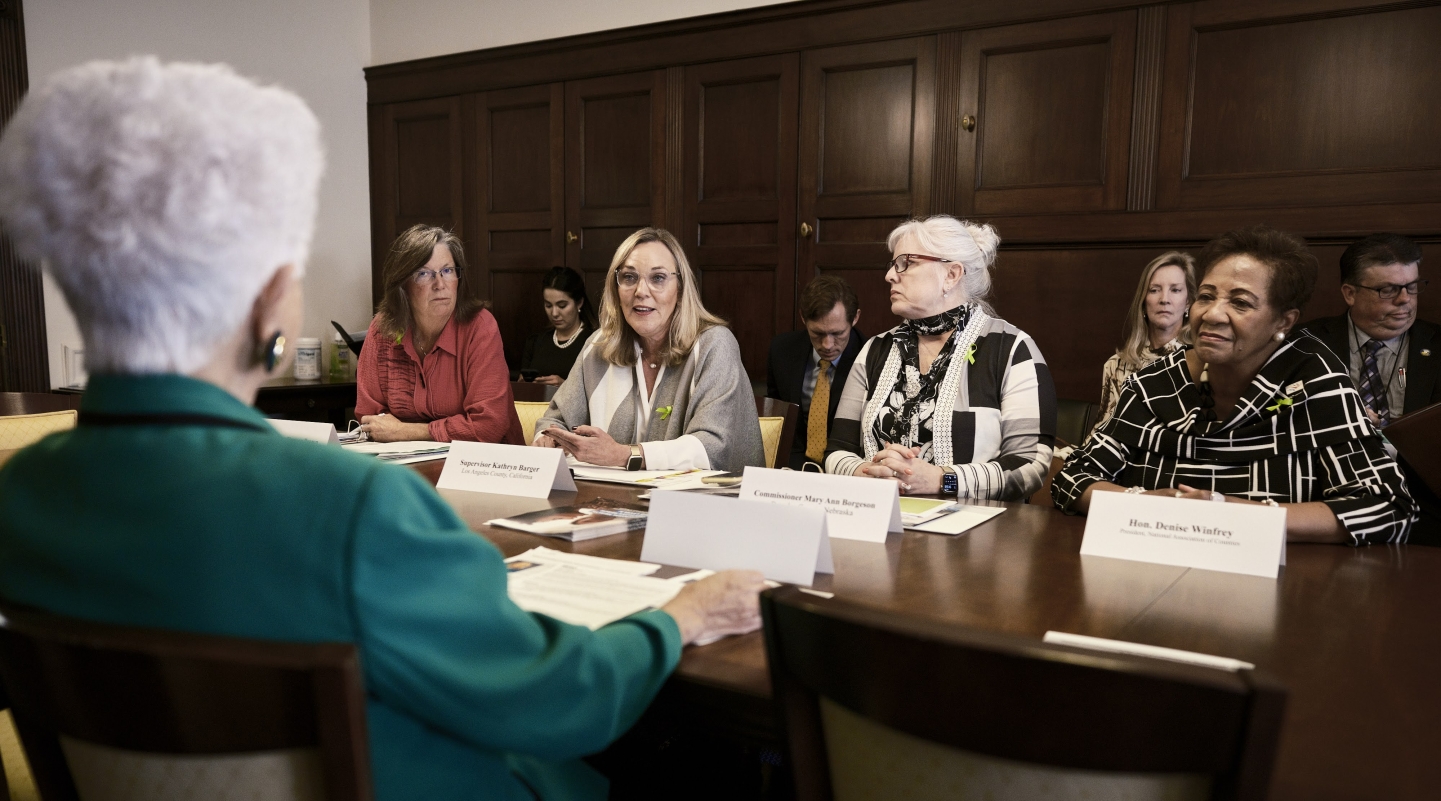2025 Federal Policy Priorities

Upcoming Events
Related News
America’s 3,069 county governments provide essential building blocks for healthy, safe and vibrant communities.
Introduction
Sections
Counties invest nearly $743 billion each year through the leadership of 40,000 county elected officials and over 3.6 million county employees. Counties support and maintain key public and community infrastructure, help nurture and sustain a skilled workforce to support dynamic local economies, and promote public health and safety to protect our citizens.
NACo supports federal policies and programs that equip county governments with the resources and flexibility needed to serve our residents effectively. NACo works to preserve local decision-making and protect counties from unfunded mandates and preemption of local authority. Because counties implement numerous federal programs and enforce various regulations, NACo urges meaningful intergovernmental consultation throughout federal policymaking.
NACo policy positions are debated and voted on by ten policy steering committees comprising more than 1,400 county officials, along with the NACo Board of Directors and full membership.
- Counties own and operate 44 percent of America’s roads and 38 percent of bridges
- Forty percent of public transit agencies are supported
- Counties invest more than $146 billion in infrastructure and maintaining and operating public works
- Sixty-two percent of counties have federal public land
- Counties support and operate more than 900 hospitals, over 700 long-term care facilities, 750 behavioral health centers and more than 1,900 public health departments
- County governments operate 91 percent of our nation’s local jails
Direct Investment in Counties
Foster Bipartisan Support for Direct Federal Investments that Flow Through Counties
NACo supports legislation that recognizes counties as essential intergovernmental partners through long-term direct investments in local governments. Counties are on the front lines of implementing federal funds at the local level, ensuring resources are used effectively to strengthen the nation’s infrastructure, health systems, economic development and local and national economies. As owners and operators of much of the nation’s critical infrastructure and providers of essential public services, counties are uniquely positioned to deliver impactful results that address the distinct needs of our communities.
We urge federal partners to work closely with counties to ensure funds are directed locally, empowering us to meet the diverse and pressing needs of our constituents. Counties are best equipped to understand the challenges and opportunities within our jurisdictions, making us indispensable partners in implementing federal programs. By providing direct investments to counties, the federal government can ensure resources are deployed efficiently, fostering innovation, resilience and economic vitality nationwide.
By the Numbers
44%
Of Public Road Miles
Counties own and operate 44 percent of all public roads
34%
Of Airports
Counties are directly involved in 34 percent of airports
40%
Of Public Transportation Systems
Counties are directly involved in 40 percent of all public transportation systems
Safeguard Local Revenue Sources
Advocate for a Fair and Flexible Tax Policy Framework that Safeguards Local Revenue Sources and Flexibility for Essential County Services
Key provisions of the Tax Cuts and Jobs Act of 2017 (P.L. 115-97) are set to expire on December 31, 2025, including but not limited to marginal rate reductions across most tax brackets, the expanded standard deduction, the Child Tax Credit (CTC) and the $10,000 cap on the state and local tax (SALT) deduction. As the 119th Congress considers extending or making permanent many of these provisions, counties have an opportunity to advance key policy priorities while ensuring critical revenue sources are protected. Counties generate revenue and reinvest nearly $743 billion annually into local communities, funding essential services like infrastructure, public safety and economic development.
County priorities include:
- Restoring the state and local tax deduction to strengthen local authority and the balance of federalism in the tax code while promoting homeownership
- Reinstating the tax-exempt status of advance refunding bonds to help counties finance critical infrastructure projects at lower costs
- Extending, expanding or establishing key tax credits that support vulnerable residents, including the Child Tax Credit, Earned Income Tax Credit and Low-Income Housing Tax Credit
State and Local Tax (SALT) Deduction - 2021 Profiles
The map illustrates the percentage of tax returns in a county with itemized deductions in 2021.
As Congress weighs options to offset the potential costs of extending the 2017 tax reform law, NACo urges lawmakers to preserve the tax-exempt status of municipal bonds. Municipal bonds are a critical local financing tool, helping counties fund more than $3.3 trillion in infrastructure investments over the past decade. Municipal bonds are typically issued as tax-exempt, meaning the interest earned by investors is not subject to federal taxation. This tax advantage makes municipal bonds a low-risk investment that can be issued at lower yields, ultimately saving taxpayers money. On average, tax-exempt municipal bonds reduce borrowing costs by 2.1 percentage points compared to taxable bonds. Without the tax exemption, state and local governments could face an additional $823.9 billion in borrowing costs through 2035.
Farm Bill
Pass a Bipartisan Farm Bill With the Inclusion of County Priorities
The Farm Bill authorizes key programs that help counties make critical investments in infrastructure, economic development, workforce training, nutrition and conservation. Preserving and expanding these programs is vital to the continued prosperity of all counties and the residents we serve.
With the current legislation set to expire on Sept. 30, 2025, counties are encouraged to connect with lawmakers now to ensure a five-year, bipartisan Farm Bill that includes key county priorities. For the nearly 70 percent of America’s counties, parishes and boroughs classified as rural, the Farm Bill represents a significant opportunity to address the unique challenges facing rural communities. Programs authorized through the bill help rural counties strengthen infrastructure, deliver essential public services, protect the nation’s food supply, expand access to healthy food, and promote locally led conservation initiatives.
The Farm Bill also plays a key role in ensuring county residents have access to affordable, nutritious food. It authorizes the Supplemental Nutrition Assistance Program (SNAP), the nation’s largest federal nutrition program, which provides monthly grocery benefits to 42.6 million low-income individuals. Counties often contribute significant local funds to help administer and supplement the program’s costs.
NACo supports the inclusion of legislation that would strengthen county engagement in federal land management, rural development and childcare services, including:
- The Treating Tribes and Counties as Good Neighbors Act, which would allow counties to retain funds from joint land management projects under the Good Neighbor Authority program
- The Rural Partnership and Prosperity Act, which would provide multiyear, flexible funding for rural development initiatives, and
- The Expanding Childcare in Rural America Act, which would prioritize rural development funding for projects that enhance childcare services in rural communities.
By the Numbers
35.7%
Of SNAP Participants
Counties are responsible for administering the Supplemental Nutrition Assistance Program (SNAP) in ten states representing 35.7 percent of total participants (15 million people)
70%
Of Counties Are Rural
Nearly 70 percent of the nation’s 3,069 counties are rural, home to 38.5 million Americans and covering over two-thirds of the nation’s land mass
Behavioral Health and Justice
Promote Better Outcomes in Behavioral Health, Homelessness, and Criminal Justice Systems
Counties invest billions annually to improve health outcomes for residents, leveraging key federal programs such as the Community Mental Health Services Block Grant and the Substance Use Prevention, Treatment and Recovery Block Grant. These programs fund essential services, including housing assistance, case management, school-based supports and peer services, helping counties address the ongoing mental health crisis. To sustain our impact, Congress must fully fund these programs.
The federal-state-local Medicaid partnership is essential for strengthening care systems and expanding access for vulnerable populations. Enhancing this partnership allows counties to continue our dual role as administrators and investors in health care, supported by initiatives such as the Prevention and Public Health Fund.
Counties also advocate for policies that remove barriers to care for justice-involved individuals. Congress is urged to amend the Medicaid Inmate Exclusion policy to reduce overall costs and improve resident outcomes. Additionally, full funding for programs such as the Justice and Mental Health Collaboration Program is critical to supporting mental health screening and treatment in jails.
By the Numbers
91%
Of All Local Jails
Counties operate 91 percent of all the nation’s local jails
44%
Of Inmates Suffer From Mental Illness
Approximately 63 percent of jail inmates are people with substance use disorder and 44 percent of jail inmates suffer from a mental illness
$130B
Counties Invest in Community Health Systems
Counties invest more than $130 billion annually in community health systems that serve approximately 75 percent of the U.S. population
PILT and SRS
Support Counties With Federal Public Lands by Fully Funding Payments in Lieu of Taxes (PILT) and the Secure Rural Schools (SRS) Programs
Counties support maintaining long-term full funding for the Payments in Lieu of Taxes (PILT), which compensates public lands counties for untaxable federal land. Without predictable mandatory funding, PILT will remain a discretionary program subject to the annual appropriations process. Public lands counties rely on PILT to provide critical services like infrastructure maintenance, clean water delivery and law enforcement to residents and visitors alike. Counties urge the administration and members of Congress to support long-term, predictable full funding for PILT in FY 2024 and beyond, and modifying the program to make PILT payments to counties with smaller populations more equitable. Counties also support extending the Secure Rural Schools (SRS) program as a transitional funding mechanism until the federal government fully implements a sustainable, long-term forest management program with adequate revenue sharing for forest counties and schools. NACo supports legislation such as the Secure Rural Schools Reauthorization Act that provides forest revenue-sharing payments to counties and promotes active natural resource management.
NACo will continue to urge leadership in both chambers and on both sides of the aisle to work together to enact a long-term, sustainable solution to ensure stable revenue sources to national forest counties. Furthermore, counties support legislation and policies which would ensure federal land management agencies aggressively reduce the excess wildfire fuels on the entire National Forest System. The annual average number of acres burned has grown dramatically from 3.3 million acres per year in the 1990s to 7 million annually since the year 2000. Counties support legislation for financing the suppression of catastrophic wildland fires without borrowing from other agency accounts for active management for forest and rangeland health and post-fire restoration and mitigation. Counties oppose any attempt to shift the costs of wildland fire suppression from federal agencies to counties.
By the Numbers
62%
Of Counties Have Federal Land
Sixty-two percent of counties have federal land within their boundaries, and unlike other local property owners, the federal government does not pay traditional property taxes
1,900
Counties with PILT Payments
PILT payments are necessary to support essential local government services in over 1,900 counties
Land Use and Environmental Planning
Promote County Priorities and Local Decision-Making in Federal Rulemaking Around Land Use, Environmental Quality and Energy Development
Counties support federal policies that balance environmental protection, public health, safety and local economic needs. As both regulators and regulated entities, counties are responsible for protecting local air, water and land resources under delegated authority from state and federal laws. Federal regulations and guidelines are most effective when they are clear, understandable and easily administered at the local level.
As the Environmental Protection Agency (EPA) and other federal agencies develop future regulations, NACo supports meaningful consultation with county governments early in the rulemaking process, and federal investments should be implemented more quickly by reforming the permitting process. Early engagement helps prevent unfunded mandates and other unintended consequences that could arise from implementing federal policies. Additionally, NACo supports increased federal funding and flexibility to counties to ensure the successful implementation of future regulations.
By the Numbers
$146B
In Wastewater Infrastructure Investments Annually
Counties invest more than $146 billion annually to build and maintain America’s water and wastewater infrastructure
$26B
Annually on Waste Management
Counties spend more than $26 billion on sewage and solid waste management annually
Disaster Preparedness Response and Recovery
Enhance the Nation's Disaster Mitigation, Response and Recovery Efforts by Strengthening Intergovernmental Partnerships
Counties play a vital role in all aspects of emergency management, including planning, preparation, mitigation, response and recovery. As the frequency and costs of disasters continue to rise, counties urge Congress and the administration to provide increased federal resources to help protect residents, property, infrastructure and local economies.
Counties support reforms to the Federal Emergency Management Agency’s (FEMA) Public Assistance Program to ensure expedited reimbursement for communities after disasters. Additionally, counties call on Congress to pass long-term reauthorization and reform legislation for the National Flood Insurance Program (NFIP) to improve affordability, mitigation assistance, flood risk mapping and program administration. The NFIP reduces the impact of flooding on public and private structures by providing affordable insurance and encouraging communities to adopt and enforce floodplain management regulations.
Furthermore, counties support increased funding for the Emergency Management Grant Program and other mitigation grants to strengthen local hazard mitigation and preparedness efforts.
2023 Total Number of Disaster Declarations
Natural Disasters
By the Numbers
849
counties with federally declared disasters
In 2023, 849 counties experienced at least one federally declared disaster
720
counties with disaster declarations
720 counties had at least one disaster declaration
312
counties with emergency declarations
312 counties had at least one emergency declaration
Local Flexibility to Support Economic Mobility
Expand Federal Flexibility, Incentives and Resources to Empower County Investments, Policies and Services
Counties play a vital role in fostering economic growth, supporting labor market recovery and building resilient communities. We advocate for federal investments such as the Economic Development Administration (EDA) to strengthen local economies through infrastructure development, workforce initiatives and public-private partnerships. Counties also call for increased funding for the Community Development Block Grant (CDBG) program, which improves housing, expands economic opportunities for low- and moderate-income residents and helps local governments address critical challenges.
To combat the affordable housing crisis, counties support modernizing the tax code to incentivize housing development and expanding programs such as the Low-Income Housing Tax Credit (LIHTC). Additionally, counties urge Congress to reauthorize the Workforce Innovation and Opportunity Act (WIOA) to address local workforce needs and emerging economic challenges while also preserving local flexibilities and resources.
Counties are also critical partners in delivering human services, advocating for expanded federal resources to combat poverty, strengthen families and support vulnerable populations. This includes increasing investments in child care, modernizing the Child Tax Credit and improving child welfare programs. Counties also support comprehensive immigration reform that imposes no unfunded mandates on local governments.
Counties call for reauthorizing the Temporary Assistance for Needy Families (TANF) program to preserve flexibility while enhancing support for family self-sufficiency. We remain committed to working with Congress and federal agencies to ensure policies promote vibrant communities, economic stability for all residents and local flexibility with accountability.
By the Numbers
$17.7B
Counties invest annually in housing
Counties invest $17.7 billion annually in the construction, operation and support of housing and redevelopment projects
33.8%
Of Children Served in Foster Care
The 11 states with a county role in the child welfare system represented 33.8 percent of the population of children served in formal foster care in 2022
$121B
Invested in Public Education Annually
Counties collectively invest more than $121 billion annually to support the public education system
Access to Technology Solutions
Ensure Access to Affordable and Reliable Technology Solutions While Preserving Local Decision-Making
Counties have an opportunity to lead in innovation by leveraging emerging technologies, including artificial intelligence (AI), to enhance local government services while ensuring residents have robust access to 21st-century communications infrastructure. AI-driven tools can help optimize broadband expansion efforts, improve service delivery, and bridge the digital divide.
County-supported technology initiatives:
- Attract and retain high-speed internet service that is affordable, reliable, and accessible for all residents, particularly in rural and underserved areas, using AI-driven data analysis to identify coverage gaps and optimize deployment strategies.
- Prioritize the county role as early partners and collaborators in wireline and wireless telecommunications siting decisions and preserve local autonomy in the management of public rights-of-way.
- Promote emerging technologies, including AI-powered solutions, to improve the effectiveness of local government services while prioritizing cybersecurity infrastructure needs and mitigating risks.
Federal funding programs, including the Broadband Equity, Access, and Deployment (BEAD) program and the State and Local Cybersecurity Grant Program (SLCGP), provide critical grant funding streams to support county technology policy priorities. Successful implementation requires strong local coordination with counties to ensure projects effectively meet local needs, leveraging AI for enhanced data-driven decisionmaking.
By the Numbers
1/3
Of Households Have 1 Or Fewer ISPs
More than a third of U.S. households have access to only one internet service provider or lack access altogether
53%
Subscribe to High-Speed Internet
Approximately 53% of U.S. households subscribe to broadband at or above the FCC’s accepted minimum definition of high-speed internet, 100 Mbps download and 20 Mbps upload
Elections and Election Workers
Maintain Election Integrity and Strengthen Election Worker Safety
In the United States, the nation’s 3,069 counties administer and fund elections at the local level, overseeing polling places and coordinating poll workers for federal, state and local elections. County election officials work closely with federal, state and local partners to ensure the accuracy, security and accessibility of voting systems.
Counties oppose legislation that imposes impractical election requirements that negatively affect the administration of state and local elections. Counties support legislation that requires federal entities to collaborate with local governments to strengthen election cybersecurity and allocate funding directly to counties.
In recent years, election officials have faced an increase in targeted threats and harassment. NACo urges Congress to enact legislation that imposes penalties for harassing or intimidating election officials in the performance of their duties.
NACo also urges Congress to reintroduce and pass legislation that strengthens protections for election officials and enhances security measures for election infrastructure and workers. This includes support for the Election Worker Protection Act.
By the Numbers
200M
People Registered To Vote
More than 200 million people typically register and are eligible to vote in jurisdictions where counties play a significant role in election administration
100K
County-Administered Polling Places
Counties administer elections through the funding and management of over 100,000 polling places staffed with over 630,000 poll workers each election cycle
36
States With County Election Oversight
Election oversight is primarily the responsibility of county governments in 36 states
Government Affairs

Mark Ritacco

Blaire Bryant

Emma Conover

Julia Cortina

Seamus Dowdall

Naomi Freel

Ben Gilsdorf

Owen Hart

Eryn Hurley

Joe Jackson

Zeke Lee

Michael Matthews

Brett Mattson

Paige Mellerio

Charlotte Mitchell Duyshart

Kevin Moore

